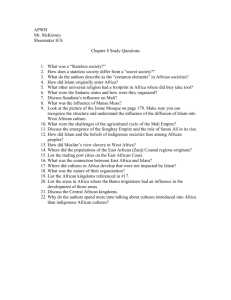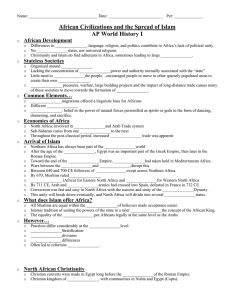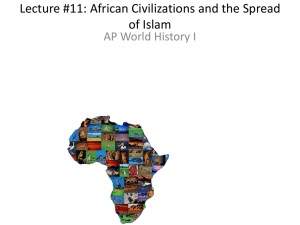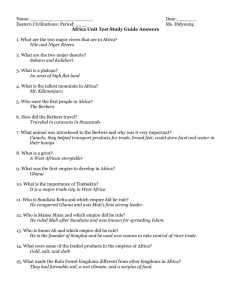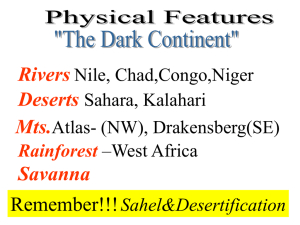African Civilizations and the Spread of Islam AP World History I
advertisement
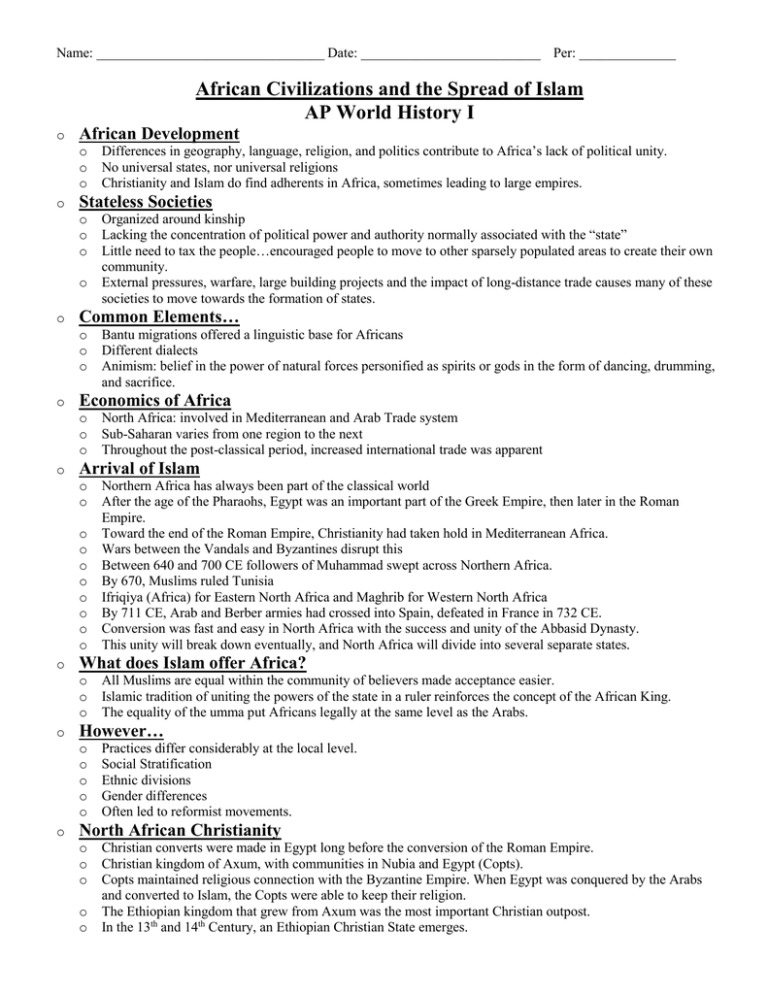
Name: _________________________________ Date: __________________________ Per: ______________ African Civilizations and the Spread of Islam AP World History I o African Development o o o o Stateless Societies o o o o o o o o o o o o o All Muslims are equal within the community of believers made acceptance easier. Islamic tradition of uniting the powers of the state in a ruler reinforces the concept of the African King. The equality of the umma put Africans legally at the same level as the Arabs. However… o o o o o o Northern Africa has always been part of the classical world After the age of the Pharaohs, Egypt was an important part of the Greek Empire, then later in the Roman Empire. Toward the end of the Roman Empire, Christianity had taken hold in Mediterranean Africa. Wars between the Vandals and Byzantines disrupt this Between 640 and 700 CE followers of Muhammad swept across Northern Africa. By 670, Muslims ruled Tunisia Ifriqiya (Africa) for Eastern North Africa and Maghrib for Western North Africa By 711 CE, Arab and Berber armies had crossed into Spain, defeated in France in 732 CE. Conversion was fast and easy in North Africa with the success and unity of the Abbasid Dynasty. This unity will break down eventually, and North Africa will divide into several separate states. What does Islam offer Africa? o o o o North Africa: involved in Mediterranean and Arab Trade system Sub-Saharan varies from one region to the next Throughout the post-classical period, increased international trade was apparent Arrival of Islam o o o Bantu migrations offered a linguistic base for Africans Different dialects Animism: belief in the power of natural forces personified as spirits or gods in the form of dancing, drumming, and sacrifice. Economics of Africa o o o o Organized around kinship Lacking the concentration of political power and authority normally associated with the “state” Little need to tax the people…encouraged people to move to other sparsely populated areas to create their own community. External pressures, warfare, large building projects and the impact of long-distance trade causes many of these societies to move towards the formation of states. Common Elements… o o o o Differences in geography, language, religion, and politics contribute to Africa’s lack of political unity. No universal states, nor universal religions Christianity and Islam do find adherents in Africa, sometimes leading to large empires. Practices differ considerably at the local level. Social Stratification Ethnic divisions Gender differences Often led to reformist movements. North African Christianity o o o o o Christian converts were made in Egypt long before the conversion of the Roman Empire. Christian kingdom of Axum, with communities in Nubia and Egypt (Copts). Copts maintained religious connection with the Byzantine Empire. When Egypt was conquered by the Arabs and converted to Islam, the Copts were able to keep their religion. The Ethiopian kingdom that grew from Axum was the most important Christian outpost. In the 13th and 14th Century, an Ethiopian Christian State emerges. o o Kingdoms of the Grasslands o o Constant struggle with Christian Ethiopia and Muslim Somalia Merchants and travelers spread the word of Islam from North Africa across the Sahara towards the Savanna on the southern edge of the Sahara The Grasslands o o o The SAHEL was the extensive grassland belt at the southern edge of the Sahara. African state of Ghana had already formed there by the 8th Century. TRADE: o Exchange gold from the forests of West Africa for salt from the Sahara (or goods from North Africa) o Camels, introduced from Asia, had improved trade possibilities. o The Grasslands o o o o Ghana o o o o o o o o o o o o o The “first” of the West African Kingdoms Rose to power in the 3rd Century CE by taxing the heavy Gold-Salt trade within its borders. By the 900’s, its rulers converted to Islam and Ghana was at the height of its power. Almoravid armies invade Ghana in 1076, and even though it survives, its power was in decline, such that by the beginning of the 1200’s (13th Century), new states emerged in the savanna. Common elements in Sudanic States Patriarch, or council of elders as leaders Territorial core with peoples of the same linguistic or ethnic background Power extended over subordinate communities which were often the result of conquest Rulers were sacred and were surrounded by rituals. Islam was used to reinforce indigenous ideas of kingship. Mali and Songhay fit the description of the fusion of Islamic and African culture. The West African Kingdoms Mali o o o o o o o o o o o o o o o o o o o o o The SAHEL becomes an active “coast” of trade between the forests to the south and North Africa. States develop along with trading cities to take advantage of their position as intermediaries in the trade. Their position in the open plains of the dry Sahel also leaves them open to attack and drought. Created by the Malinke people who broke away from Ghana. Rulers supported Islam by building mosques, public prayers, and supporting preachers. In return, sermons would encourage loyalty to the king. Mali became a model of the Islamicized Sudanic Kingdoms Economic base was agriculture Sundiata: Malinke leader who led towards prosperity as the state of Mali. The Mansa, or emperor Crime was severely punished (as evidenced by Ibn Batuta, the Arab traveler). Security of travelers and trade was a key element to Mali’s success as a state where commerce plays such an important role Sundiata dies around 1260 CE. Of his sucessors, Mansa Musa was the most famous (r. 1312-1337) Made pilgrimage to Mecca in 1324 Cities and towns of West Africa came to be modeled after North Africa, but with a distinctive flair. Cosmopolitan court life. “Port” cities flourish like Jenne and Timbuktu/ By the 14th century Timbuktu had a population of 50,000. Contained a library and university. 80% of the villagers lived by the agricultural lifestyle. Labor intensive Polygamy was common Songhay o o o Songhay begins to form around the 7th century. By 1010, a capital had been established at Geo on the Niger River. Rulers became Muslim Dominated by Mali for a while o o o o o o o o o o o o Political Life in the Sudan o o o o o o o o o Coastal cities developed from the mixture of Bantu migrants, as well as with Indonesian seaborne migrants. Settled on the island of Madagascar, introducing bananas and coconuts. Coastal villages of fishers, farmers dotted the coast Zenj: Arabic for the East African Coast. 13th Century: urbanized East African trading ports develop. Shared Bantu-based and Arabic Influenced Swahili (coastal) language. Different Muslim ruling families, but similar language united them in trade. Towns such as Mogadishu, Mombasa, Malindi, Kilwa, and Zanzibar. Ibn Batuta said of Kilwa that it was “one of the most beautiful and well-constructed towns in the world” Kilwa was wealthy because of its control over Sofala Access to the Gold produced in the interior Farthest point south in which Indian ships could reach in one monsoon season Many port towns were tied to each other in an active trade network. 1300s-1400s: large state sponsored sailing expeditions stopped at the East African coast for ivory, and gold. After 1431, only the Arabs and Indians continued this trade. Central/Southern Africa While the impact of trade and Islam radically altered the West/North/East African “coasts”, Central and Southern Africa was developing on its own trajectory. o By 1000 CE, still small agricultural societies, preliterate, but with great strides in arts, building, and statecraft…without writing. Artists… o Terra Cotta objects discovered in Nok, in the forests of Central Nigeria dating to 500-200 BCE. o Terra Cotta and bronze portrait heads were found among the Yoruba people of Nigeria o o From the Horn of Africa to modern-day Mozambique lay a string of Islamicized trading cities with contacts from Arabia, Persia, India, and China. As in the Savanna Kingdoms of West Africa, Islam was slow to reach the general population in East Africa, and when it did, it was a fusion of indigenous beliefs and the new Islamic faith. East Africa o o o o o o o o o o o o o o o o Slave trade between Africa and the Islamic World predated the arrival of Islam Muslims viewed slavery as a stage in the process of conversion. Slaves were used as domestic servants, laborers, soldiers, eunuchs, concubines. Concentration on women and children across the Sahel to the East African coast. The Swahili Coast of East Africa o o Unified states allowed the various communities, clans, and ethnic groups to coexist. Movement and fusion of populations was constant in the Sudan Common religion and law provided solidarity and trust to the merchants. Organized under Muslim concept of a ruler who united civil and religious authority. Formation of large state heightened social differences and made societies more hierarchical. Islam tended to accommodate pagan practices and beliefs. Large populations of Mali and Songhay never converted. Many Sudanic states were matrilineal, which is contrary to patrilineal lines of kinship in the Sharia, or Islamic law. Slavery o o o o o By 1370’s, had established themselves as an independent state Under the leadership of Sunni Ali (1464-1492) the Empire of Songhay began. Tactical commander Ruthless leader. Successors known as askia’s. Muhammad the Great expanded the borders of the empire. By the 1600’s, Songhay dominated the central Sudan Remained the dominant power in the region until the end of the 16th century. In 1591, a Muslim army with muskets crossed the Sahara and defeated the larger forces of Songhay. Songhay split up, but other groups experienced success in the Western Sudan The Hausa peoples of Northern Nigeria o The Yoruba o o o o o Benin o o o o By the 5th Century CE, Bantu farmers and fishers reach beyond the Zambezi 13th Century, they were approaching the southern end of the continent. Beyond the scope of Islam By 1000 CE, many of these groups were forming states. Kongo o o o o o o o Similar settlement patterns as the Yoruba can be found among Edo people who formed the state of Benin. Ewuare the Great (r. 1440-1473) extended Benin’s control from the Niger River to the Coast. The Oba, or ruler, lived in a huge royal compound. Central African Kingdoms o o o o o Agricultural society supported by a peasantry and dominated by a ruling family and aristocracy. Spoke a non-Bantu language and recognized a relationship with the Hausa, who spoke Afro-Asian language. Small city-states, each controlling about 50 miles. Highly urbanized. Late 15th Century, the Kongo was forming along the lower Congo River. Agricultural base, with skills of weaving, pottery, blacksmithing, and carving. Men: Clearing the forest, producing palm oil and palm wine, building houses, hunting, long-distance trade. Women: Cultivation, care of animals, household duties, made salt from seawater, collected seashells which were used as currency. Great Zimbabwe o o o Farther to the east, among the farming and cattle-herding Shona-speaking peoples. Creation of GREAT stone enclaves to serve as the capital town area. By the 15th century, a centralized state had begun to form controlling central Africa to the Indian Ocean.
